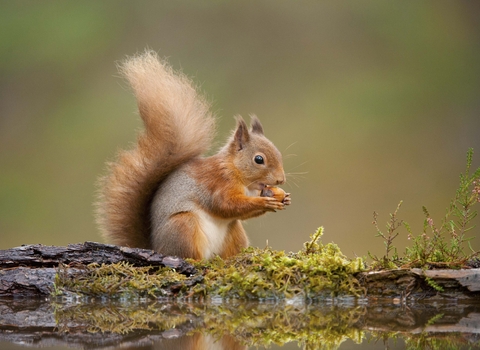
Red squirrel © Mark Hamblin/2020VISION
Red squirrel
Red squirrels are native to the UK but are a lot rarer than their grey cousins. They live in a few special places across the UK thanks to reintroduction projects.
Scientific name
Sciurus vulgarisWhen to see
January to DecemberSpecies information
Category
Statistics
Length: 18-24cmTail: 17-18cm
Weight: 100-350g
Average lifespan: 6 years
Protected in the UK under the Wildlife and Countryside Act, 1981. Priority Species under the UK Post-2010 Biodiversity Framework.
Habitats
About
Native red squirrels are a lot rarer in the UK than their American cousins, grey squirrels. Usually found in coniferous woodland, they like to feast on hazelnuts by cracking the shell in half. If you’re lucky you may also find pine cones that have been nibbled, leaving what looks like an apple core behind! Red squirrels make a rough nest called a ‘drey’ out of twigs, leaves and strips of bark high up in the tree canopy. Males can be seen chasing females through the trees, leaping across branches and spiralling up tree trunks.How to identify
The red squirrel has a reddish-brown coat and pale underside. It has a characteristically bushy tail. It is distinguished from the grey squirrel by its smaller size, red fur and distinctive, large ear tufts.Distribution
Found in Scotland, the Lake District and Northumberland; isolated, remnant populations further south in England and Wales, including Formby, Anglesey, Brownsea Island in Dorset, and the Isle of Wight.In our area
In Northern Ireland, red squirrels are a priority species and are protected by Schedule 5 and 6 of the Wildlife (NI) Order 1985. The best places to see them include County Fermanagh, the Mourne Mountains and the Glens of Antrim.
Did you know?
Red squirrels do not hibernate, but they do keep stores of food to see them through difficult times when fresh food is not available. In their favoured habitats of mixed broadleaf and coniferous woodland, they have a source of food all year-round as pine seeds are present over the winter months.Watch
Red Squirrel (https://vimeo.com/642268637)
John Bridges
In Northern Ireland, red squirrels are a priority species and are protected by Schedule 5 and 6 of the Wildlife (NI) Order 1985. The best places to see them include County Fermanagh, the Mourne Mountains and the Glens of Antrim.
